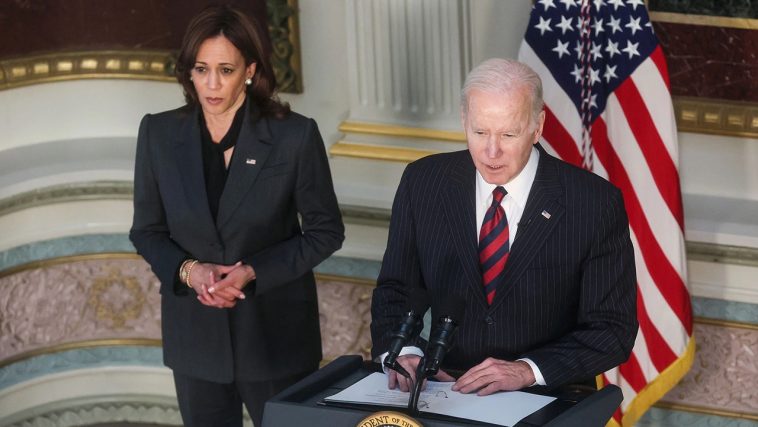Reports of American job growth in the preceding year have recently undergone a major reassessment, showing an inflated estimation by over 800,000 jobs. The Bureau of Labor Statistics has released information highlighting that the job growth noted in the year leading up to March would require a downward adjustment by 818,000 positions. This substantial decline equates to roughly half a percent of all jobs, as indicated by The Washington Examiner.
BREAKING: 818,000 jobs that the Harris-Biden administration claimed to have “created” aren’t actually there, according to the Bureau of Labor Statistics.
This is the largest downward revision to employment in 15 years. pic.twitter.com/6ryjKs5kbK
— RNC Research (@RNCResearch) August 21, 2024
To put that into perspective, any downwardly adjusted figure exceeding 501,000 jobs would be the highest such adjustment in a decade and a half. Consequently, the average monthly job growth within the evaluated period would be lessened from an estimated 242,000 to about 174,000 job opportunities, proving to be a momentous alteration.
However, these are still preliminary numbers, as part of an annual reassessment that cross-verity and modifies monthly reports’ accuracy with the much slower, yet more reliable, state government data compilations. This account comes from The New York Times, a source known for its comprehensive coverage of socio-economic events.
Once the revised data have undergone thorough analysis and corrections been made, they will then be integrated into the official government records over the following year. This feature allows every yearly revision to oust outliers from monthly data, providing a clearer picture of the national economy’s performance.
The adjusted job growth figures also seem to fall in line with other economic indicators that had shown a discrepancy from the robust employment records obtained over the past year. Evidence thus suggests that these determined figures may have presented an unauthentic insight into the national economy’s wellbeing.
Recognizing this, Michelle Bowman, a noteworthy figure in the Federal Reserve’s Board of Governors, indicated that the employment market’s robustness may not be as omnipresent as payroll data suggest. Her speech on Tuesday made note of the possibility that underlying ‘risks’ may have been overlooked.
The deflated job statistics might be invoked by Federal Reserve authorities next month if the prevailing economic atmosphere motivates a cutback on interest rates. Reducing interest rates could set the stage for a new economic narrative in the foreseeable future.
The potential for this economic shift could be something that Vice President Kamala Harris could employ during her campaign. The lower interest rate might be the buoy she needs to secure a stronger connection with the American populace, many of whom remain apprehensive about the economy’s outlook.
The reality of significantly lower job growth could imply that the hiring boom was losing momentum even before April. This insight was shared by economists Sarah House and Aubrey Woessner of Wells Fargo. They suggest that the revised figure might have more serious implications than merely a statistical anomaly.
The suggested ‘large negative revision’ could highlight the uncertainty surrounding the Federal Reserve’s goal of achieving full employment. The underlying risks might become more evident, considering the prevalent ‘softening’ in other data pertaining to labour market performance.
This, combined with concerns about the actual strength of the employment market, could indeed change the way economists and policymakers discuss and outline future strategies for economic stability. After all, the strength and growth of the national economy have knock-on effects for both domestic and international considerations.
In conclusion, these revisions point to a need for greater accuracy in initial reports and underscore the significance of authentic data representation in understanding the true state of our economy. The process also sheds light on the willingness of our institutions to rectify inaccuracies and provide the public with a realistic portrayal of economic indicators.
As we move towards the future, the need for transparent, accurate data will only increase in importance. Especially because these figures have real-world implications for both individual and collective decision-making, impacting everything from personal financial planning to national policy strategies.
As the final round of analysis and corrections occur, it’s expected that the revised figures will be released to the public and integrated into the official data sets. This is a clear demonstration of the importance our government attaches to an open and honest representation of the true state of our economy. And it’s an essential piece in the puzzle of understanding the broader picture of our nation’s financial health.
These adjustments to existing estimates also highlight the necessity for a cross-verification method between the various sources of information. Whether it’s payroll data or state-level statistics, the lessons learned from this scenario enhance our robust systems for examining and interpreting socioeconomic data.
As we go forward, we must continue to respect and appreciate the importance of these revisions. They play a crucial role in providing us with accurate, reliable data that we can trust. They also ensure that the representation of our economy is as accurate as possible, thereby providing guidance for future decisions impacting the national economic landscape.


